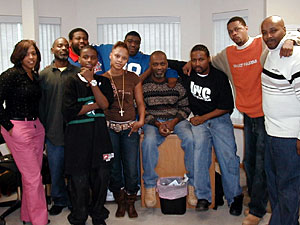|
Photos
Resources
|
 |
| Urban Youth Conservation staff ages range from teens to more than 40 years old. Many of the men are former gang members who have served prison time. (MPR photo/Dan Olson) |
Minneapolis, Minn. — Thirty-five year old Khabir Rasheed is resplendent in his blue and red shirt with Harlem Globetrotters stitched in gold on the back. The barrel-chested former gang member is one of the newer recruits to the Urban Youth Conservation project. His pitch to young people attracted to gangs is straight forward.
"At the end of these roads there's no positive stories. It's always a negative. Somebody's dead, somebody's in jail, somebody's brother's dead, somebody's sister got raped. There's no positive ending to this lifestyle. We are trying to change all that," he says.
Twenty-three year old Antwon Davis buys the message.
Davis left a gang and signed on with Urban Youth Conservation as an outreach worker. Davis says he was involved in all the bad things gangs are blamed for. Leaving the life, he says, was not easy. He weighed the outcomes of gang affiliation - death or prison - and opted for change.
"Change is getting up out of those streets, putting that gun down, putting that drug pack down, domestic violence, running the streets all day, stealing, beating people up, assaults. I mean gang violence, what is it for, what can you get up out of gang except negativity, dead or in jail?" he says.
Davis delivers his message like an evangelist. It's attracting other young black teens and men by the dozens.
Urban Youth Conservation has enrolled 190 in it's various programs. The group gets some grant money from the Minneapolis Foundation among other sources. But it has bumped up against it's limits. More kids want to sign up than the organization has money for.
Anthony Shelby, a former gang member now in his 30's directs the group's activities in south Minneapolis. He says once someone makes a decision to leave a gang and sign on with Urban Youth Conservation the organization has to move fast to connect him to something positive.
"That means we've got to get them to a transitional group where they can learn how to take care of themselves as far as a job or what not, you know what I mean, and back away from the madness in the streets and everything," he says.
Sometimes, Jimmy Stanback says, the group can't move fast enough. Stanback, 32, another former gang member, is co-founder of Urban Youth Conservation. He remembers two young men dubbed the 'lottery robbers'. The two held up people in north Minneapolis. When they made the decision to give up their law-breaking ways and sign on with Urban Youth Conservation, Stanback says, the two redirected their energy to signing up kids for the organization's basketball program.
"And these two kids were the best. They recruited more basketball teams than anybody else. They were out on the street corners, out there on the same part of town they were terrorizing, they were out there recruiting their friends to become a part of this project...," he says.
But their change of heart came too late.
Stanback says one day the police arrived as the two were reporting for their Urban Youth Conservation work and arrested them.
Using former members to lure young people away from gangs is a widely used and successful strategy. The success is apparent on a weeknight at Jerry Gamble Boys and Girls Club in north Minneapolis. Hundreds of young black teens fill the center. Many are Urban Youth Conservation basketball players. Center director Kevin Stringer says the turnout shows young people are hungry for positive activity. Stringer's wish is for more adults who will be tutors and role models.
"I don't believe the kids aren't trying. I believe now it's the adults gotta put in the work. We have to put in the work for the children," he says.
So far there's no Urban Youth Conservation program for young women. The organizers vow to change that. But it all comes back to money. Even so 20-year old Phyllicia Wise shows up to help with he group's activities. Wise says spending priorities that don't include young people are misguided.
"We look at it as the funding isn't needed for the kids to get into a program. The funding is needed for the war, the funding is needed for Section 8 and all this." Wise says. "I mean there's nothing wrong with money for Section 8 and welfare and all that, but my thing is you need to understand and prioritize where the money is going and where the money is actually needed, and I think as a society we don't really understand that. Money is still needed in activities."
Urban Youth Conservation outreach worker Khabir Rasheed points to the season's tradition of gift giving as one way to view the organization's work.
"Christmas is about giving and it started out giving to a child. We basically are trying to give back to those kids, those kids that are lost, we're trying to give them a gift, the gift of life."







